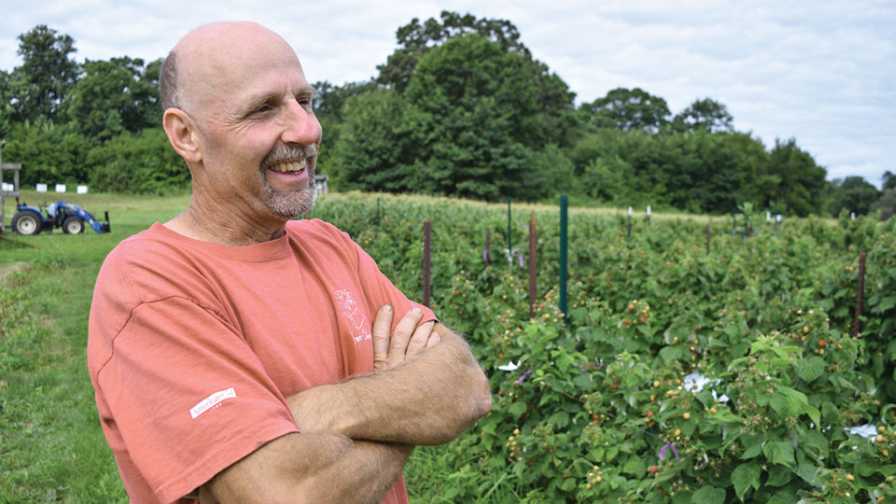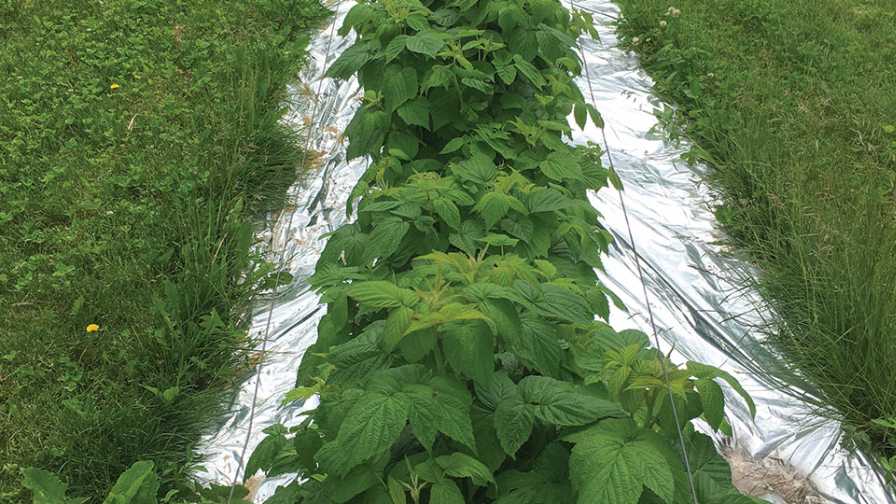Can Mulch Protect Raspberries from Spotted Wing Drosophila?

Ed Bures owns a 14-acre vegetable and fruit farm near Barneveld, WI. He’s struggling to grow raspberries in the face of spotted wing drosophila.
Photo by David Tenenbaum, University of Wisconsin-Madison
Spotted wing drosophila (SWD) has devastated crops in many parts of the country, arriving in Wisconsin more recently (2010) than in other states.
Familiar with SWD’s behavior, Christelle Guédot, Associate Professor of Entomology at the University of Wisconsin–Madison, finds the pest’s local population puzzling.
“We don’t have any flies in the middle of winter, while other states have flies continuously throughout the year,” she says. “We see them until about New Year’s Eve and then don’t see any until June. It’s very confusing to us in the Midwest, because we have warmer temperatures in March, April, and May, and we have susceptible crops. Yet, we don’t see the flies.”
As part of the university’s research and Extension programs, Guédot and her Ph.D. student, Hanna McIntosh, are trying to understand SWD’s local population as well as the crops it affects. Wisconsin is the largest producer of cranberries, but SWD only affects this fruit when it’s already been compromised. The area’s cold-weather grapes used for winemaking are also safe because the insect can’t cut the fruit’s skin. SWD doesn’t seem to take much of an interest in summer strawberries either but hits fall raspberries hard.
Ed Bures owns a 14-acre fruit and vegetable farm not far from the university, with about a quarter acre of raspberries. Though the plot is small, it’s seen large devastation from SWD.
“If we pick daily, we lose 10% to 15% of our crop,” Bures says. “But if we have rain and can’t get out there, and fruit becomes overripe, we can lose as much as 90%.”
Bures says he’s tried insecticides but has to apply them frequently. Also, the associated pre-harvest intervals mean he sometimes can’t step foot in the patch for days, which is difficult when berries are quickly ripening.
Knowing that SWD like a shady, warm, humid canopy, and that larvae drop to the ground to pupate, Guédot and McIntosh thought lining the ground with impermeable plastic mulch may help protect raspberries.

Mulch is different than weed mat. While both help warm soil and manage weeds, weed mat is often made of a thicker, woven plastic. Plastic mulch is more like a thick garbage bag material. Each differently conducts and retains heat.
Photo by Hanna McIntosh, University of Wisconsin-Madison
Multicolored Approach
The team is testing their theory with two cultivars, ‘Caroline’ and ‘Polana,’ in the Bures patch. Last spring, they placed strips of polyethylene plastic mulch on either side of the raspberry plant rows. They’re also testing various colors of mulch. One is metallic silver, reflective like tin foil. Another is black on the bottom but white on the top. A third is black on both sides. Of course, there’s also a control patch.
“The metallic, reflective mulch may help change the environment in the canopy by directing the sunlight into the crops, making it hotter, brighter and less humid — less desirable for SWD,” says McIntosh. “The black mulch gets really hot in the sun to create a kind of frying effect that kills the fallen larvae. Then the white may serve as an intermediate that can be reflective while also heating up a bit.”
Just wrapping up their first season of field testing, the researchers are still collecting data. But they’re excited by what they’ve observed so far.
When SWD lay eggs in the fruit, larvae eat the inside, destroying it so that the berry is no longer marketable. Guédot and McIntosh are looking to see if the mulch will reduce the number of larvae in the fruit. They collect the berries and submerge them in saltwater to bring larvae to the surface. This makes the larvae easier to see and count. So far, it appears there are fewer larvae in the mulch plots than in the control group.
“We’re not sure if the mulches are deterring the flies from laying eggs in the fruit, but fewer larvae mean growers will have to throw out less fruit,” McIntosh says. “That’s promising.”
The team is also testing to see how long larvae that fall to pupate can survive on the mulch. McIntosh modified plastic storage containers by cutting off their bottoms and adhering pieces of each mulch. This ensures the larvae are contained and safe from predators. All the larvae on the black mulch died in an hour, while larvae on the other mulches survived no more than three hours.
“Larvae don’t have exoskeletons like adult insects,” McIntosh says. “So it’s really easy for them to dry out, even when it’s not really hot on the mulch.”
Speeding Growth?
Along with co-advisor Amaya Atucha (UW-Horticulture Department), McIntosh is also looking at fruit quality and plant growth to make sure the mulches don’t have negative effects on the crops. Other outside research has shown that mulch can lead to increased plant growth. This may be because the mulch is insulating heat near the plant, mobilizing nutrients, and reflecting more light into the canopy to increase photosynthesis. McIntosh is looking to see if this is the case with the raspberry crop.
As research continues, Guédot currently recommends that growers use a combination of practices to manage SWD. She suggests thinning vegetation to ensure good canopy airflow. Remove and destroy all dropped fruit. Also, pick berries every other day to remove those with damage, and harvest those that are marketable. Refrigerate the good fruit to stop larvae development if any eggs are present.
Many local growers use fall-bearing raspberries to extend their growing season, so the research team is doing likewise. However, Guédot recommends using summer-bearing raspberries to avoid SWD. This is because the SWD population doesn’t build until the end of July into August.
“While summer business usually revolves around strawberries, SWD don’t seem to bother berries in the summer as they do in the fall,” she says.
Bures also recommends that growers don’t let customers pick their own berries, because people will leave compromised fruit on the plant and proliferate the problem. He’s hopeful that the researchers will come up with a solution. If not, he plans to cut back or eliminate his raspberry crop.
“It’s so difficult to raise the berries in this condition,” he says. “It becomes an unprofitable business.”










